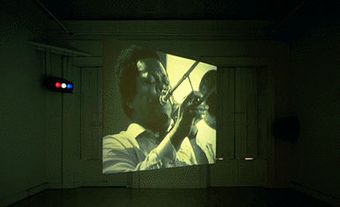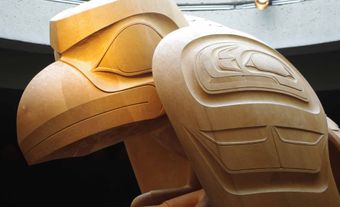William Rodney Graham, OC, artist (born 16 January 1949 in Abbotsford, BC; died 22 October 2022). Rodney Graham was known for his conceptual sculptures, text-works, photography and films. Described by the Georgia Straight as “one of Canada’s greatest multi-discipline art stars,” he is often associated with the Vancouver School of artists, which includes Jeff Wall, Ian Wallace, Ken Lum, Stan Douglas and Roy Arden. Graham was especially notable for the ways in which he incorporated various technologies — and the history of technology — into his artworks, much of which deals with the conflict between nature and culture in a resource-extraction economy. He was made an Officer of the Order of Canada in 2016.
Education and Early Career
As an undergraduate at the University of British Columbia, Graham was interested in writing and literature until he took a course in modern art with Vancouver photo-conceptualist Ian Wallace, who opened him up to the wide range of possibilities in the visual arts. Graham ended up collaborating with Wallace and Jeff Wall, who was by then a professor at UBC and whose thesis on the Berlin Dada movement Graham read, on an aborted film project.
One of Graham’s earliest works, which anticipated his ongoing interest in archaic technologies, is Camera Obscura (1979). For this work, Graham created a camera obscura, an optical device that enables an inverted image to be projected from a small aperture in a wall, out of a makeshift shed on his family farm in Abbotsford, British Columbia. On the opposite wall inside the shed appeared a single upside-down image of a tree. For a relatively simple piece of technology, the camera obscura has had a disproportionate impact on the history of art: it was used by Dutch master Johannes Vermeer and other low country artists as an aid for realistic painting and was at the root of the invention of the camera and photography. The upside-down image of a tree, which is precisely what happens on a photographic negative, is a reminder that photography, while often appearing to provide transparent access to the actual world, is in many ways as much of an artifice as painting.
Visual Arts
Camera Obscura led directly to what may be Graham’s best known, and most easily recognizable works: his sequence of upside-down black-and-white photographs of oak trees. Taken in different places and of trees with a variety of properties — Flanders Trees – Oak, Kaggevinne (1989) is lush and sprawling, whereas Oak Trees, Red Bluff (1993) is a denuded, leafless skeleton — the photographs all make a simple point both about the nature of representation, photography, and perhaps also about landscape and portraiture: the ways in which they present themselves to us, whether as works of art or as natural perception, is contingent in many ways on the technologies we use and the physiology we have.
Graham also created numerous pieces that make use of, and radically reconfigure, literary works. The System of Landor’s Cottage: A Pendant to Poe’s Last Cottage (1987), for instance, uses the last story written by Edgar Allan Poe, “Landor’s Cottage,” and adds to it a first-person narrator who describes a room in the cottage that contains an elaborate machine that appears to have no rational purpose whatsoever. Taking as his point of departure one of the pioneers of horror and detective fiction, Graham seems to be suggesting that for modern life the real horror, and mystery, is technology. For Reading Machine for Lenz (1993), on the other hand, he created an apparatus that presents the first five pages of early 19th-century German literary prodigy George Büchner’s novella Lenz in such a way that the ordering of words and phrases is arbitrary and repetitive. As with Camera Obscura, here Graham is pointing out that our assumptions about the way either the natural world or literature, for that matter, are experienced is contingent upon the ways in which technology is brought to bear.
Graham’s best-known public artwork is Spinning Chandelier, a 14-foot by 25.5-foot crystal chandelier that hangs under the north end of Vancouver’s Granville Street Bridge, at Beach Avenue. Based on Graham’s 35mm film installation, Torqued Chandelier Release (2005), the chandelier lowers twice each day, lights up and spins for four minutes, before rising back to its original position. Commissioned by a local real estate developer at a final cost of $4.8 million, the work generated significant controversy after being unveiled on 27 November 2019.
Film
For many years, Graham worked in relative obscurity. But in the late 1980s, he began to be included in important international exhibitions. He is especially well known in Belgium, where his work is seen to have parallels with the work of the avant-garde Belgium poet, filmmaker and artist Marcel Broodthaers.
By the 1990s, however, Graham had become frustrated with the more cerebral, conceptual work, which had occupied his career up to that point. His first video, Halcion Sleep (1994), which is also the first time he himself performed in one of his works, has him taking a Halcion sleeping pill in a motel room in the suburbs of Vancouver. Once he is knocked out, he is picked up by his brother, loaded into a car, and transported back to his home downtown in what he has described as a “reverse kidnapping.” While Halcion Sleep was shot in the grainy black-and-white familiar from conceptual art videos of the 1970s, Graham’s contribution to the 47th Venice Biennale, Vexation Island (1997), was shot in bright colour in a style reminiscent of classic Hollywood films. Vexation Island features a marooned seafarer, played by Graham, ragged and asleep beneath a coconut tree. When he wakes up, hungry and thirsty, he shakes the tree, and immediately a coconut falls on his head and knocks him out cold. Vexation Island marks a turning point in Graham’s career, bringing him significant international attention.
Vexation Island also marks the point at which Graham began exploring film genres and popular culture. What followed was a series of ironic costume dramas and period pieces. How I Became a Ramblin’ Man (1999) has Graham riding across the desert and into the sunset, singing a cowboy ballad. City Self/Country Self (2000) is set in 19th-century Paris, where a city dandy, decked out in period attire, arbitrarily boots a threadbare peasant in the pants. A Reverie Interrupted by the Police (2003) has Graham decked out in striped prison clothes, sitting at a piano playing a fragmented, atonal tune, anxiously glancing back at the police officer standing behind him; the performance is interrupted when prison guards arrive and take him off stage. Rheinmetall/Victoria 8 (2003), on the other hand, is a black-and-white silent film of a 1930s German Rheinmetall typewriter projected by a 1961 Victoria 8 film projector. The shots are long, static, photographic close-ups revealing the inner mechanisms of the typewriter. Eventually, snow begins to fall, covering the typewriter. Rheinmetall/Victoria 8 involves the confrontation of two obsolete, analog technologies that are not quite wholly extinct, and that still work. Yet people don’t write any better now than they did on those old German Rheinmetall typewriters, one can’t help thinking, and the beauty of the images in the film speak for themselves.
Style
Graham's art uses a strategy he called “annexation,” an ironic posture that differs from “appropriation” in the sense that his artwork will annex itself to existing works. For example, he has added a lengthy passage to Edgar Allan Poe's text Landor's Cottage, produced a series of sculptures based on the works of Donald Judd and composed a work of music, using some bars of Wagner's Parsifal, that will take some years to play.
The overarching themes of Graham's work centre on systems declining into entropy. Much of his work deals with the conflict between nature and culture in a resource-extraction economy. His work on Freud extends into an interrogation of the modern psyche.
Major Exhibitions
Rodney Graham had travelling retrospectives of his work at the Barcelona Museum of Contemporary Art in 2010 and at the Vancouver Art Gallery in 2012. He also had solo exhibitions at the Hamburger Banhof, Berlin (2001), the Whitechapel Gallery, London (2002), the Museum of Contemporary Art, Los Angeles (2004), and the Institute of Contemporary Art, Philadelphia (2005). His work was included in the documenta Ix (1992), the Venice Biennale (1997), the Whitney Biennial (2006) and the Carnegie International (2013). Also in 2013, Graham’s photograph Basement Camera Shop was used as a stamp by Canada Post.
Graham was made an Officer of the Order of Canada in 2016. He died of cancer in 2022 at the age of 73.
See also Rodney Graham (Profile).
Awards
- Gershon Iskowitz Prize (2004)
- Kurt Schwitters-Preis, Niedersächsiche Parkassenstiftung, Germany (2006)
- The Audain Prize for lifetime achievement in the arts (2011)

 Share on Facebook
Share on Facebook Share on X
Share on X Share by Email
Share by Email Share on Google Classroom
Share on Google Classroom






